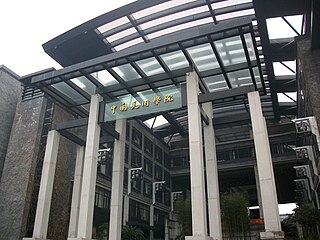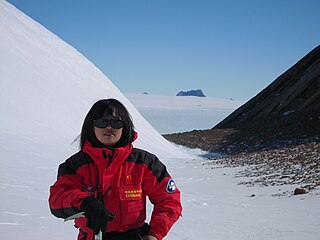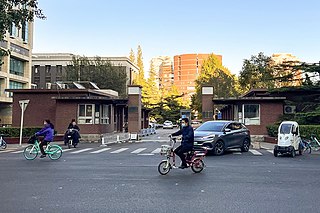Related Research Articles

The China Academy of Art is a provincial public fine arts college located in Hangzhou. Zhejiang, China. It is affiliated with the Zhejiang Provincial People's Government, and co-sponsored by the Zhejiang Provincial People's Government, the Ministry of Education, and the Ministry of Culture and Tourism. The academy is part of the Double First Class University Plan.
The National Astronomical Observatories, Chinese Academy of Sciences(NAOC, Chinese: 中国科学院国家天文台; pinyin: Zhōngguó Kēxuéyuàn Guójiā Tiānwéntái) is an astronomical research institute operated by Chinese Academy of Sciences, along with Shanghai Astronomical Observatory, Purple Mountain Observatory and National Time Service Center.
Kunming Institute of Zoology (KIZ) (中国科学院昆明动物研究所), one of the 20 biological institutes under the Chinese Academy of Sciences (CAS), is one of China's first class zoological research institutes, located in Kunming, Yunnan province. The Institute has access to the unique and diversified animal resources of the Eastern Himalayas as well as a wide variety of the species from across Southeast Asia, the southern parts of Yunnan province being part of the Indo-Burma biodiversity hotspot. KIZ focuses on life science research, with research groups including systematic zoology, conservation biology, cytology, molecular biology, genome evolution, reproductive and developmental biology, neurobiology, immunological biology on important virus disease, zoological toxicology and primate biology.
Wuyi University is a public university based in Jiangmen, Guangdong, China.
Solenaia is a genus of freshwater mussels, aquatic bivalve mollusks in the family Unionidae.
Boltonia lautureana is an East Asian species of plants in the family Asteraceae. It is native to China, Japan, Korea, and Asiatic Russia.
Platynosomum capranum is a species of trematodes found mainly in Kunming, Mainland China. It is the 4th species of Platynosomum found to be parasitic of mammals and the first species in this genus recorded from China.

Wei Lijie is a Chinese Antarctic researcher, best known for her work on the paleontology and stratigraphy of Tibet and the Antarctic.
Hexacontium pachydermum is a species in the genus Hexacontium of the family Actinommidae. It was described by Eugen Honoratius Jørgensen in 1899.
In 1965, Chinese scientists first synthesized crystalline bovine insulin, which was the first functional crystalline protein being fully synthesized in the world. Research on synthesizing bovine insulin started on 1958. Members in the research group were from the Chemistry Department of Beijing University, Shanghai Institute of Biochemistry, CAS and Shanghai Institute of Organic Chemistry, CAS.

The Institute of Physicsof the Chinese Academy of Sciences was the result of a merger, after the communist took control of the mainland China in 1949, between the Institute of Physics of Academia Sinica (IOPAS) founded in Shanghai in 1928 and the Institute of Physics of National Academy of Peiping (IOPNAP) founded in Beiping in 1929. The director of the IOPNAP, physicist Yan Jici, was appointed director of the new institution after the merger was completed in 1950. The new entity was named the Institute of Applied Physics before being renamed to Institute of Physics in 1958. In Taiwan, the IOPAS was re-established in Taipei in 1962 by another "founding father" of modern Chinese physics - Wu Ta-You.
Phintella abnormis is a spider species of the family Salticidae.

Gao Fu, also known as George Fu Gao, is a Chinese virologist and immunologist. He served as Director of the Chinese Center for Disease Control and Prevention from August 2017 to July 2022 and has been Dean of the Savaid Medical School of the University of Chinese Academy of Sciences since 2015.
Zhuang Weimin is a Chinese architect who is a professor and dean of the School of Architecture, Tsinghua University. He is a member of the International Union of Architects (UIA), China Green Building Association (CGBA), APEC Architect Project Monitoring Committee, Architectural Society of China (ASC), and UIA International Professional Practice Commission.
Jin Hongguang is a Chinese physical chemist, fellow of the Chinese Academy of Sciences.
Polygonatum arisanense is a flowering plant within the Asparagaceae family. The species is endemic to Taiwan and is found in areas around 1,500 meters in elevation. Its Chinese common name and species name refer to the Alishan Range.
Zhuang Zhanggong was a Chinese chemist. He was a founding member of the Chinese Academy of Sciences.
Chen Xu is a Chinese geologist who is a researcher at the Nanjing Institute of Geology and Paleontology, and an academician of the Chinese Academy of Sciences.

Dopasia hainanensis, the Hainan glass lizard, is a species of lizard of the Anguidae family. It is endemic to Hainan Island in China.
Xin Zhou is a Chinese scientist specializing in magnetic resonance imaging. He is currently serving as president of the Innovation Academy for Precision Measurement Science and Technology of the Chinese Academy of Sciences since July 2022.
References
- 1 2 "Prof. Wenying Zhuang, elected to Chinese Academy of Sciences". www.mscfungi.org. Retrieved 2019-03-31.
- ↑ "China Vitae : Biography of Zhuang Qiaosheng". www.chinavitae.com. Retrieved 2019-03-31.
- 1 2 3 "Synopsis of Principal Investigator - State Key Laboratory of Mycology". www.mycolab.org.cn. Retrieved 2019-03-31.
- ↑ Luo, Jing; Zhuang, Wenying (2008). "Two new species of Cosmospora (Nectriaceae, Hypocreales) from China". Fungal Diversity. 31: 83–93. Retrieved 2019-03-31.
- ↑ Zhuang, Wen-Ying (庄文颖); Zeng, Zhao-Qing (曾昭清) (2007). "中国二头孢盘菌属的分类研究". 菌物学报 (in Chinese). 35 (7): 791–801. doi:10.13346/j.mycosystema.160047. ISSN 1672-6472.
- ↑ International Plant Names Index. W.Y.Zhuang.